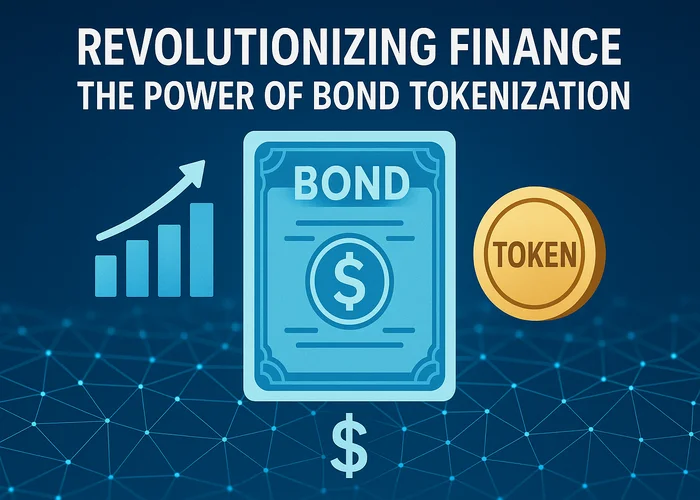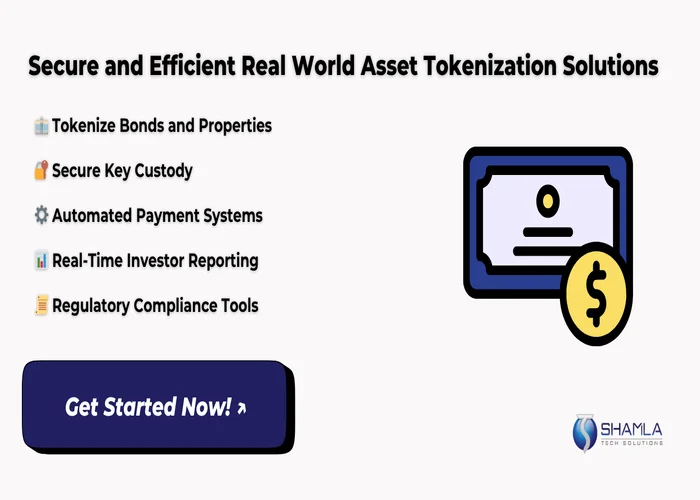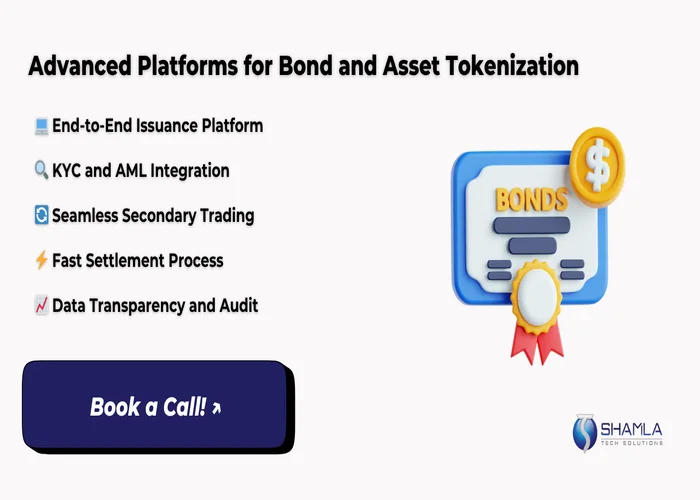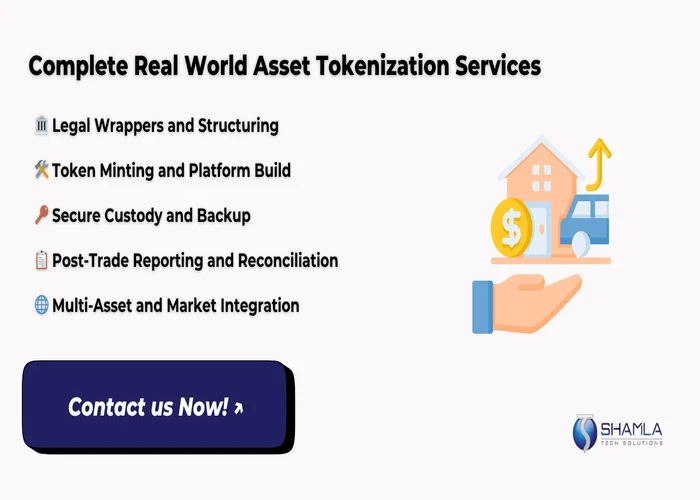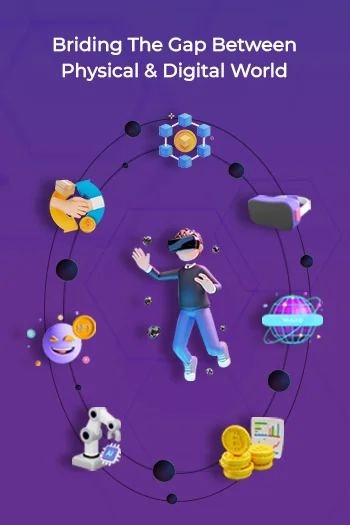Bond tokenization turns a bond into many digital tokens that can be bought and sold. It lets small and large investors trade slices of debt with faster settlement and lower fees. Issuers can record ownership and rules on a secure record, improving checks and cutting middle steps.
Using digital bond assets makes reporting and transfers quicker and clearer, and can open new markets across borders. When platforms run on blockchain in finance, they provide audit trails and automated rule checks. Proper legal rules and custody keep investors safe. This setup can make fixed income markets more open, cheaper, and faster.
Understanding Bond Tokenization and Its Role in Modern Finance
Bond tokenization means turning a debt issue into many small tradeable digital parts that live on a shared ledger. Issuers can split principal and sell parts to more buyers, which lowers the entry size and widens demand. Coded rules automate payments and transfers so settlements finish faster.
Records on the ledger show clearly who owns what and limit hidden changes, which helps checks. For investors, digital bond assets lower minimums and let people access new markets without heavy paperwork. Regulators can add on-ledger checks so trades follow rules. Fixed income tokenization reduces cost and speeds settlements and cuts middle steps.
Role of Bond Tokenization in Modern Finance
1. Market Access and Liquidity
By splitting large debt into small pieces, bond tokenization widens who can buy and sell. Tokenized bonds can list on digital trading venues that run longer hours and accept small orders. This change increases market depth and narrows gaps between buy and sell prices.
Smaller investors join, and new market makers add quotes. Platforms use shared ledgers to match orders faster and to clear trades with fewer steps. This reduces the time assets sit unsold and cuts the cost of trading. More active trading also helps set true prices across regions and currencies and supports cross-border settlement without extra banks.
2. Lower Costs and Faster Settlement
Bond tokenization cuts steps that add cost in traditional debt deals. Issuers use coded rules to set payments and ownership checks, so manual reconciliation and middle steps fall away. Fewer middle steps mean lower fees from banks and agents and smaller delays before cash moves.
For issuers, fixed income tokenization can lower issuance costs and shorten funding time. Investors see quicker cash flows and fewer hold-ups when they buy or sell. Reduced friction also lowers price swings caused by slow settlement. Over time, these savings can make issuing debt cheaper and expand which projects can afford to borrow and scale.
3. Fractional Ownership and Investor Reach
Splitting debt into small pieces creates digital bond assets that let many people own a part of the same loan. This change lowers the money needed to enter the market and brings in retail and offshore buyers. Tokenized bonds can be programmed to pay interest to holders automatically and to record each change of owner.
Platforms can show real-time holdings and past payments so buyers verify income history before they bid. This setup supports new investor groups like family offices and smaller funds, and it gives issuers a wider pool of steady buyers for future deals with clear transfer rules.
4. Regulatory Compliance and Custody
Regulators can require clear IDs and on-ledger checks so trades follow rules. When issuers list regulated tokenized securities, platforms must add identity checks, limits on who can buy, and clear records of each transfer. Custody services store private keys and keep backup copies so owners do not lose access.
Shared ledgers let supervisors trace flows and spot breaches faster than paper trails. This makes it easier to apply tax rules and investor protections across borders. Proper custody and clear rule checks help build trust and let more funds consider tokenized issues. Platforms must log events and keep public proof records.
5. Transparency and Auditability
Recording ownership and events on a shared ledger gives clear proof of who bought and sold and when. Auditors can check the ledger history to confirm payment flows without paging through paper files. With bond tokenization, timestamps and hashes lock each record so changes are visible and old data stays intact.
This reduces disputes and speeds reconciliation between parties. Investors can see past coupon payments and principal returns before they buy. For trustees and agents, clear records cut review time sharply and lower the chance of missed fees or wrong transfers, which saves money and strengthens trust.
6. New Product Design and Distribution
New bond types and payout schemes become possible as systems let issuers code terms directly. Bond tokenization supports sliced coupons, step-up rates, and auto-repayment triggers that execute without manual clearing. Engineers build payout rules on shared platforms so investors receive funds without extra paperwork.
Using shared ledgers and tools from blockchain in finance lets firms run these features across markets and currencies. In practice, combining ledger logic and finance tools reduces setup time and lets dealers offer tailored bundles to client needs. Platforms using blockchain in finance also let issuers scale distribution quickly across regions and cut manual reconciliation costs.
Key Benefits and Use Cases of Tokenized Bonds and Digital Bond Assets
1. Market Access and Liquidity
By turning big debt into small tradable parts, markets get real-time liquidity and clearer prices. Tokenized bonds sit on shared ledgers that record every trade at once, letting platforms match buy and sell orders fast. Market makers can offer narrow prices because they can move pieces quickly and settle them without long waits.
Small buyers enter with low sums, which raises demand and cuts the gap between listed prices and real trades. Trading that moves fast reduces sharp price swings and helps set fair values across markets. Digital bond assets expand access and speed.
2. Lower Costs and Faster Settlement
Issuers cut fees and time because many manual steps drop away. Tokenized bonds use coded rules to handle interest payments and ownership moves, so banks and agents no longer do repetitive checks. Shorter flows cut settlement delays and lower funding costs for issuers while shrinking counterparty risk for buyers.
Platforms can batch and net trades to reduce cash transfers and ledger entries, saving fees. For buyers, faster settlement clears cash holds and reduces failed trades. Decentralized Finance bonds models also show how code can lower costs and speed settlement across chains and markets, and allow smaller issuers to access capital faster.
3. Wider Investor Base
Splitting debt into small parts opens investment to more people and places. Digital bond assets let retail buyers, family offices, and foreign funds hold parts that once needed big capital. Platforms enforce investor rules and show real-time holdings and past coupon payments to build buyer trust.
Greater investor reach cuts dependence on a few large buyers and raises steady demand for new issues. Issuers get access to diverse capital pools and may find longer-term holders. Real world asset tokenization anchors payouts.
4. Programmability and New Product Features
Issuers can code payment rules, call options, and priority rights into digital bond assets, which lets them offer precise cash flows without paper. Decentralized Finance bonds use similar code to enforce triggers and move funds when conditions occur.
Code can raise coupons, call principal, or split cash among tranches automatically at set events. That reduces reliance on manual trustees or clearing agents and cuts execution lag. Investors pick bonds that match their income needs and test scenarios before they buy. Developers can audit code to confirm the logic.
5. Transparency and Reporting
Shared ledgers store every trade, payment, and change with a timestamp and a proof hash, so auditors and trustees can trace cash flows without piles of paper. Tokenized bonds record coupon dates and principal transfers in clear order, which cuts dispute time and speeds reconciliation. Regulators can inspect issuance terms and confirm investor eligibility more quickly.
Custody providers use ledger records to prove who owns keys and to manage recovery steps when holders lose access. Faster data access shortens monthly closes and lowers audit fees. Clear transaction logs help markets react to real events with less guesswork and reduce gaps.
6. Cross-Asset Bundles and Yield Engineering
Linking debt to other assets creates mixed products that meet narrow income goals and spread risk. Platforms can bundle rent or lease cash with bond streams to form notes that pay steady amounts. Benefits of real estate tokenization appear when property rent backs regular coupons, lowering default risk and boosting recoverability.
Issuers can slice pools into senior and junior tranches so buyers choose yield or safety. Cross-asset bundles also let issuers tap new capital sources and let investors diversify in a single trade. Clear legal rights and custody make these bundles tradable across markets. Regulators must map rules to rights.
Exploring Bond Tokenization Platforms and the Future of Regulated Tokenized Securities
1. Platform Infrastructure and Custody
Issuers use Bond Tokenization Platforms that give ledger, issuance, registry, and custody tools to run deals without paper. They store legal records, manage private keys, and link to bank rails so cash and tokens move. Core services include:
- Issuer onboarding with identity checks.
- Secure key custody and backup.
- Settlement links to payment systems.
This setup reduces manual steps for trustees and lowers error risk. Issuers can publish terms and let auditors see clear logs. Investors get proof of ownership and payment history. Platforms add reporting feeds for regulators to check compliance quickly.
2. Regulatory Gateways and Compliance Tooling
Top platforms embed on-chain checks and legal wrappers so issuers can list regulated tokenized securities while meeting local rules. Systems include automated KYC, AML monitoring, investor class gating, and transfer limits enforced at the token level. Key functions:
- Buyer eligibility enforcement and holder caps.
- Sanctions screening and automated reporting.
- Configurable lockups and transfer holds.
By codifying these controls, issuers cut manual legal review and speed offering launches. Regulators get audit exports and clearer terms. This lowers compliance cost and supports faster market entry while keeping investor protections and tax reporting aligned with law.
3. Market Access, Secondary Trading, and Liquidity Layers
Marketplaces linked to Bond Tokenization Platforms host order books and matching engines that handle small unit trades and cross-rail settlement. These venues support market maker incentives, batching, and netting to keep spreads low and cut settlement load. Core items:
- Continuous trade matching and quote display.
- Cross-rail adapters for settlement.
- Lifecycle event feeds and status publishing.
Together these parts boost secondary trade and let investors move tokenized assets with clear rules. They let issuers show price history and run liquidity programs that attract diverse buyers.
4. Product Engineering and Programmable Features
Issuers use templates on Bond Tokenization Platforms to code payment waterfalls, call windows, and tranche logic so payouts execute without paper. Developers build reusable templates for fixed coupons, step-up rates, and indexed payouts that trust code to move funds when triggers occur. Key templates:
- Modular payout blocks.
- Configurable tranche priority and size.
- Condition-triggered or time-locked releases.
Using templates cuts setup time and trustee work, lowers launch costs, and lets issuers test scenarios before they sell. Buyers get clearer rules and predictable cash flows, and platforms reduce manual errors in payment runs.
5. Interoperability, Market Standards, and Future Proofing
Top Bond Tokenization Platforms adopt tokenization-on-blockchain standards and open APIs so registries, custody, and trading systems exchange data cleanly. They join consortia to set shared metadata, message formats, and lifecycle event names that reduce mismatch and support audit. Typical workstreams include:
- API sync for custody and registry.
- Standard event vocabularies for lifecycle states.
- Adapters to legacy back-office systems.
By aligning standards, platforms make it easier to list regulated tokenized securities across venues and countries and reduce vendor lock-in. This lowers cost, speeds checks, and eases listing.
Real World Asset Tokenization and Its Impact on UAE Real Estate Investment
1. Mechanics of Real World Asset Tokenization
Real world asset tokenization turns a property right into many small digital tokens that represent shares of that asset on a ledger. Issuers create a clear legal wrapper, mint tokens that map to ownership shares, and list them on a regulated platform so buyers can trade pieces.
Markets see each token transfer recorded, and payment flows tie to bank rails or on-chain rails as agreed. This model lets owners sell parts of a building or project without selling the whole. Tokenized assets give fast proof of who holds each share and let transfers happen with fewer manual checks than paper registers.
2. UAE Real Estate Tokenization: Local Change, Global Reach
UAE real estate tokenization lets developers and funds split property income and sales receipts into tradable slices. Dubai and Abu Dhabi frameworks now support digital listings where nonresident buyers can acquire parts of projects under clear local rules.
RWA tokenization in real estate investment helps match offshore capital with onshore assets while keeping transfer rules and taxes clear. Platforms handle ID checks and local compliance, so sales meet Emirate rules and investors see real-time holdings. This opens projects to many small investors and helps builders raise money faster without relying only on big banks.
3. Platforms and Real World Asset Tokenization Services
Specialist providers run platforms that combine registry, custody, and payment tools into one product. Real world asset tokenization services cover investor onboarding, drafting legal frameworks, minting tokens, and post-trade reporting, enabling issuers to avoid rebuilding systems from the ground up.
Providers also offer custody for keys and reconciliation feeds to accounting systems so finance teams match cash and token movements easily. On the platform, issuers set transfer limits and lockups and configure payouts to route rent or sales proceeds to token holders automatically. Using a single vendor cuts setup time and reduces the chance of integration errors across back offices.
4. Investor Outcomes and the Benefits of Real Estate Tokenization
Small investors gain access to property income streams that were once reserved for large buyers, and issuers get a broader pool of steady capital. Fractional ownership smooths cash flow matching, and secondary trading boosts exit options for holders. The benefits of real estate tokenization include lower entry amounts, clearer payout records, and faster transfers when investors sell.
Proper services keep legal rights intact and custody safe, which reduces counterparty worry. For portfolio managers, tokenized holdings make diversification and rebalancing simpler because they can trade small lots without heavy fees or long settlement waits.
Conclusion
Bond tokenization breaks debt into small digital pieces that trade fast, cut costs, and widen access. Regulated tokenized securities add legal checks and custody to protect investors. Real world asset tokenization links physical assets to tokens, opening capital sources and making markets more liquid, transparent and efficient for issuers globally.
Shamla Tech is an RWA tokenization development company that helps issuers tokenize bonds and other real world assets and builds platforms to manage issuance, custody, and trading. We handle legal procedures, key custody, payment links, integration and reporting so clients launch tokenized offerings quickly and meet full regulator checks.
Contact us today to start Tokenizing Bonds and other real-world assets!

